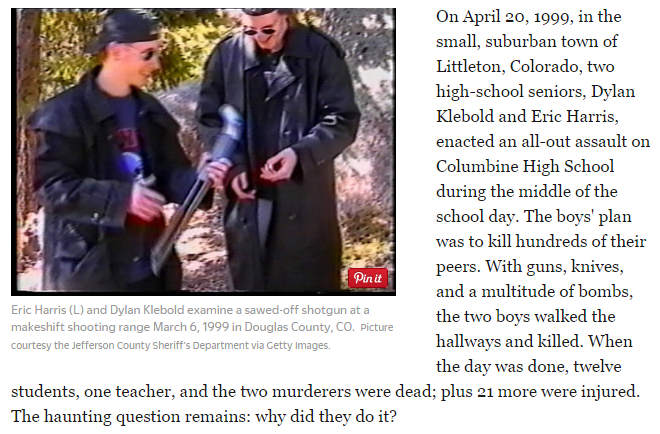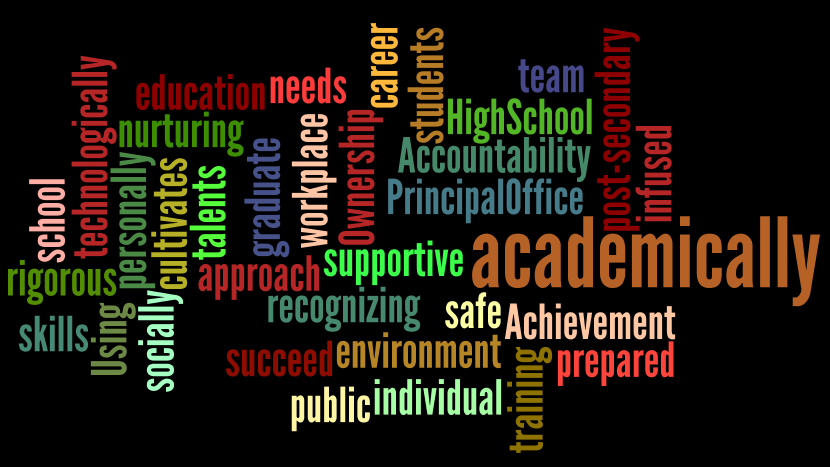- In 1999, two students walked into Columbine High School and murdered thirteen people, injuring 21. They then killed themselves.
- In 2014, a student walked into Franklin Regional High School and stabbed 25 people with a pair of 8" kitchen steak knives.
- FactCheck.org states there have been 62 major school shootings since Columbine (including both K12 schools and universities).
 |
| http://history1900s.about.com/od/famouscrimesscandals/a/columbine.htm |
The shooting was immediately picked up by the national news media and became the lead story. Typically the first voices heard after such a horrific incident are those with a vested interest and a pre-existing point of view. On the far right was the National Rifle Association.
In May of 1999, under intense pressure following the Columbine High School massacre, National Rifle Association CEO Wayne LaPierre told Congress that the gun lobby supported instant background checks at gun shows. On Wednesday, back before the Senate Judiciary Committee following the mass shooting at Sandy Hook Elementary School in Newtown Connecticut (26 people shot, 2012), LaPierre uncomfortably withdrew his support for universal background checks. (Huffington Post)In fact, after the shooting at Sandy Hook ES, the NRA CEO responded with the famous quote "The only thing that stops a bad guy with a gun, is a good guy with a gun”. The NRA then stated what we should do: put an armed security guard in every school. He offered to have the NRA train these security guards. But he did not offer to pay for this "good guy with a gun" approach.
On the left, the call was for gun control. The belief was that if you make it harder to get guns (background checks) and you limit access to semi-automatic and automatic weapons, you will lessen the probability of a violent act in a school. After both Columbine and Sandy Hook, hundreds of bills were brought up at the federal and state level to regulate gun ownership.
Even though the success rate for gun control on the federal level is near nonexistent, that doesn't mean politicians aren't sponsoring gun legislation. They just aren't hitting any home runs. A New York Times report from December 2013 found that 1,500 gun bills — including the failed Manchin-Toomey background check bill that failed in the Senate — had been introduced around the country since the shooting in Newtown the previous year. Only 109 became law. On the federal level, the only policy changes came from the executive branch, with President Obama's 23 executive actions to reduce gun violence.Clearly, national leadership from either the right or the left have had little impact on school violence. "The status quo reigns."
The response at the state level has been even more alarming.
After the Newtown, Conn., rampage last December, 33 states considered new legislation aimed at arming teachers and administrators, according to an analysis by the National Conference of State Legislatures. (New York Times 9/27/2013).In Pennsylvania, State Senator Don White just proposed a bill that would allow teachers and school staff to bring guns to work. I'm guessing the assumption is that if a student comes into the school waving a gun or knife, they would be shot by a staff member thereby saving the school. One can only imagine how this would work. Non-trained civilians packing guns to protect their students.
Sometimes I believe our approach to school violence harkens back to the Wild West and John Wayne... Let's make sure we shoot them before they shoot us.
 A conference was just held in Pittsburgh to look at what schools should do to prevent school violence. When I first saw the Post-Gazette headline I thought we might find some new thinking about school violence. Both the educators and the experts discussed how to be vigilant in terms of security, preparedness, practiced protocols and risk management. Basically they were promoting best practices on what should occur when a student appears in a school with a weapon. Certainly, this is a good idea since it works toward minimizing injuries and possibly death.
A conference was just held in Pittsburgh to look at what schools should do to prevent school violence. When I first saw the Post-Gazette headline I thought we might find some new thinking about school violence. Both the educators and the experts discussed how to be vigilant in terms of security, preparedness, practiced protocols and risk management. Basically they were promoting best practices on what should occur when a student appears in a school with a weapon. Certainly, this is a good idea since it works toward minimizing injuries and possibly death. However, there is a subtlety here that needs to be addressed. Being vigilant from a security perspective does not prevent violent attacks, it simply limits the damage when a violent attack occurs. Short of locking down every window and door, having metal detectors and body searches at every entrance and having a full time armed security force, there is no way to completely stop this violence.
What shocks me about the continuing "Columbine conversation" is that it never looks at the perpetrator. How did it come to be that some individual or groups of individuals decide to come into a school and destroy peoples lives? What form of neglect, abuse, isolation, mental illness and anger causes a youth to obtain a weapon, plan a violent assault on teachers and classmates and often end the assault by committing suicide? Do you believe there was no evidence of these behaviors prior to the incident?
There is a fundamental problem in our society as reflected in our schools that pertains to individual responsibility. The problems that a child brings to school from his/her home life are not the school's responsibility. It is not the school's or community's responsibility to raise your child. Mom and Dad just need do a better job.
That's well and good until the school, its staff and students, suffer the consequences and challenges of a society that is becoming more isolated and less supportive from a child's perspective. A large number of our children:
- grow up in a single parent family;
- have no father;
- come home to an empty house after school;
- eat dinner alone;
- passively sit in front of a television for many hours a day;
- spend a huge amount of time building relationships with remote people over the Internet;
- live with a parent who is struggling financially, emotionally or physically;
- consume intense violence via the media and online entertainment;
- have access to firearms;
- witness addiction in their families; and
- have noone to talk to.
Students spend 183 days, over 1000 hours a year in school. With its educated faculty and access to counselors, social workers and administrators, schools are in an excellent position to early identify and address adjustment issues with at risk students. Schools that focus on the needs of their students as individuals can provide an early warning system for students who are struggling and beginning to check out.
I would suggest that many educators in schools that have experienced a violent event, in retrospect, had already identified students who might be prone to such a violent act. The problem is they are working in schools that aren't proactive. They don't consider it to be the school's responsibility to intervene with students who are isolated and not adjusting well to the difficult socialisation of school aged children.
Please consider reading a post I wrote on this blog about what a school would look like if it had a culture of proactive support. Here are just a few aspects of such a school:
- Administrators who greet the students every day as they enter and leave the school.
- Faculty that go out of their way to build relationships with students based on support, caring and early intervention when problems arise.
- Faculty advisors for all students.
- A zero tolerance policy on bullying.
- Social workers who provide drop in services.
- A full time school nurse.
- An active early intervention system (it is called SAP - Student Assistance Program in Pennsylvania).
- School security that gets to know the students and demonstrates a positive attitude to the students.
James Surowiecki recently wrote about our country's habit of being reactionary rather than proactive (New Yorker, 9/22/2014.) Here is what he suggests.
"Our system has a fundamental bias toward dealing with problems only after they happen, rather than spending up front to prevent their happening in the first place. We spend much more on disaster relief then on disaster preparedness. And we spend enormous sums on treating and curing disease and chronic illness, while under investing in primary care and prevention."A caring, thoughtful and proactive school community would identify at-risk students and help them and their parents seek services. Making schools into healthy, supportive communities would pay huge dividends from both a safety and academic perspective.
Pay it now... or pay it later. We never considered that we might pay for it with our students and teachers lives.

No comments:
Post a Comment